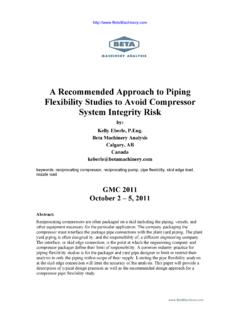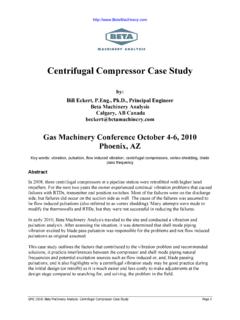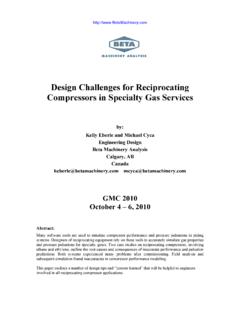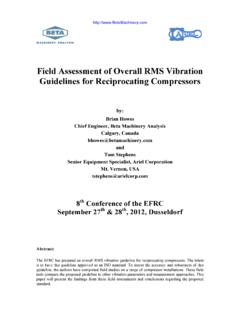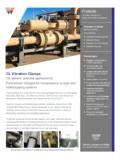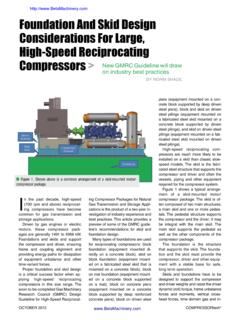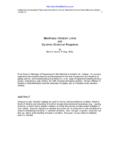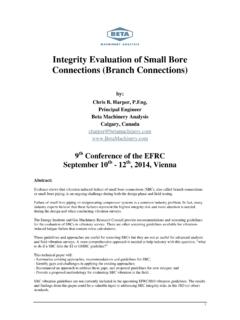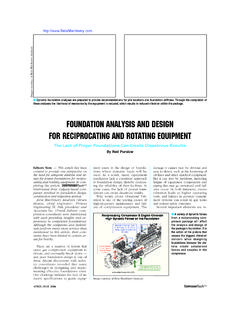Transcription of NEW API STANDARD 618 (5TH ED.) AND ITS ... - Beta …
1 A key section of the STANDARD focuses on the design tocontrol pulsation and vibration for reciprocating compressorsystems, section This section of the STANDARD is usedthroughout the industry, including high-speed purpose of API 618 is to establish minimum designrequirements. Later, in this presentation, API recommendsthat the user and manufacturer go beyond these minimumstandards and aggressively pursue designs that improveefficiency and minimize total life-cycle costs (as opposedto acquisition cost alone). The following points summarize key changes incorpo-rated in the Analysis:For cases where the piping designis not available, the pulsation supplier can perform a pre-study, or damper check, to calculate bottle should be aware of consequences to this ap-proach (see below).
2 Unbalanced force guidelines for pip-ing and vessels are defined. Line side pulsation guideline has been updated to ac-count for the specific speed of sound of the gas (now al-lows for higher pulsations in low-density gas and lowerpulsations in high-density gas).Allowable pressure drop criterion now includes a guide-line for dynamic pressure drop as well as steady-statepressure drop. The pulsation analysis must consider the full range ofconditions including different gas analysis, all planned operating conditions and load steps. If multiple units areconnected together through a com-mon piping system, then a multi-unit analysis is requiredto ensure the cumulative pulsation effects are addressedand comply with STANDARD .
3 Vibration Control:To avoid resonance and excessive vi-bration, mechanical analysis of the compressor package isneeded to recommend modifications to the piping forced response (formerly known as M6 and M7)studies are no longer required on all Design Approach 3(DA3) projects. These studies are only required if the pulsa-tion and mechanical design do not meet the requiredguidelines. In addition, more specific instructions are pro-vided on how these studies should be performed to ensureaccurate results. Editor s Note:The new API STANDARD 618 (5thEdition) af-fects how packagers and owners design reciprocating com-pressor packages to avoid pulsation- and vibration-relatedproblems.
4 Shelley Greenfieldis vice president of Engineering DesignServices at beta machinery Analysis, Calgary, Alberta, leads the company s design teams, structural, foundationand skid design services, customer support and training initia-tives. This includes managing relationships with Beta s cus-tomers, OEMs and packagers in Asia, Europe and North/SouthAmerica. Greenfield has 23 years of direct experience in per-forming API 618-related design studies and activelypartici-pated on the API 618 STANDARD 5thedition pulsation task has published technical articles and presented at varioustechnical conferences in North America and Europe.
5 She re-ceived a BSc degree (Mechanical Engineering) from theUniversity of Calgary and is a Professional Eberleis a principal engineer at Beta with over 20 years ofdesign and field experience, particularly in the area of pressure pulsation analysis and mechanical analysis of recipro-cating compressor and pump installations, and structural analy-sis for offshore projects. The scope of his design experience in-cludes acoustical simulations, thermal flexibility studies, static and dynamic finite element analyses, structural analysisand foundation analysis. He directs Beta s Research andDevelopment group focusing on new analysis tools and techniques. Eberle has published technical articles and presented at the GMRC, EFRC and The Vibration Institute.
6 He re-ceived his BSc degree in Mechanical Engineering from theUniversity of Saskatchewan. Changes to Pulsation, Vibration, Torsional, Skid,Engineering StudiesSummary of API STANDARD 618 and Key Changes inthe 5thEdition API STANDARD 618 (the STANDARD ) is therecognized specification for owners and manufacturers ofreciprocating compressors. The 4thEdition of API 618 waspublished in 1995. During the following 12 years, the in-dustry identified many enhancements to this STANDARD ,which were included in the new 5thEdition, published inDecember 2007. The STANDARD can be purchased on on-line at COMPRESSORTechTwoNEW API STANDARD 618 (5TH ED.) AND ITS IMPACT ON RECIPROCATINGCOMPRESSOR PACKAGE DESIGN API 618 5thEdition (the STANDARD ) Only Specifies Minimum Requirements More Aggressive and Innovative Approaches Can Realize Significant SavingsBy Shelley Greenfield, and Kelly Eberle former M8 study (stress analysis of the bottle inter-nals) is optional and is to be done only if specified by theowner.
7 The margin of separation between the MechanicalNatural Frequency (MNF) and shaking force, or excita-tion, frequency is 20%. In addition, the minimum MNFmust be greater than times maximum run speed. Vibration design guidelines have been added. The owner and packager are encouraged to exceedthese standards to improve efficiency and reduce total life-cycle costs. We refer to this as optimized design practices. Pulsation and Vibration Control (section of theStandard): There are three design approaches for pul-sation and vibration control, which is consistent with the4thEdition. The new 5thEdition of the STANDARD no longeruses M study terminology to designate the separatestudy components ( , M2 for pulsation study, M3 forperformance analysis).
8 The following application selection chart (see below) isnow included. The recommended design approach (DA) isbased on the compressor discharge pressure and ratedpower per cylinder. Selection Chart: For Pulsation/Vibration Study Scope(note: DA1 = Design Approach 1, DA2 = Design Approach2, DA3 = Design Approach 3)A more detailed application selection chart, Beta s RiskRating chart1, has been developed to incorporate evenmore system parameters that affect pul-sation and vibration2. The definition ofthe design approaches in the new 5thEdition is similar to the 4thEdition butwith some important differences. The5thEdition includes a description of thedesign criteria and the necessary stepsrequired to meet the various DesignApproaches.
9 The revised STANDARD in-cludes several flow charts to describethese steps and Design Approaches,which are complicated and can be dif-ficult to interpret. Following is a simpli-fied description of the DesignApproaches and analysis Approach 1 (DA1, also Step1):The scope includes basic bottle siz-ing using empirical calculation. Thisdoes not include pulsation study (con-sistent with 4thEdition).Design Approach 2 (DA2, also Step2):The scope includes pulsation con-trol design in conjunction with a mechanical review (basicvessel calculations and review pipe runs and anchoring sys-tem). Pulsations are to be analyzed with acoustic simulationto assess pulsation, forces and pressure drop.
10 The DA2scope does not include mechanical modeling to following simplified flow chart identifies two ways todesign the pulsation solution. The recommended approachprovides a more reliable, efficient and lowest overall pulsa-tion control solution (compared with optional approach,discussed below), but requires piping layout optional approach can be undertaken if bottlesmust be ordered before the piping system is bottle sizes are based on a pre-study, or dampercheck. This is an acoustical simulation of the gas pas-sages and bottles based on a line connection with infinitelength. The drawback with this approach is that the pack-ager/owner will have difficulty optimizing the pulsationcontrol solution once the final piping system is deter-mined; pressure drop may be higher, bottles may need tobe redesigned, and additional pulsation analysis may beneeded at a later date to determine support requirements.
